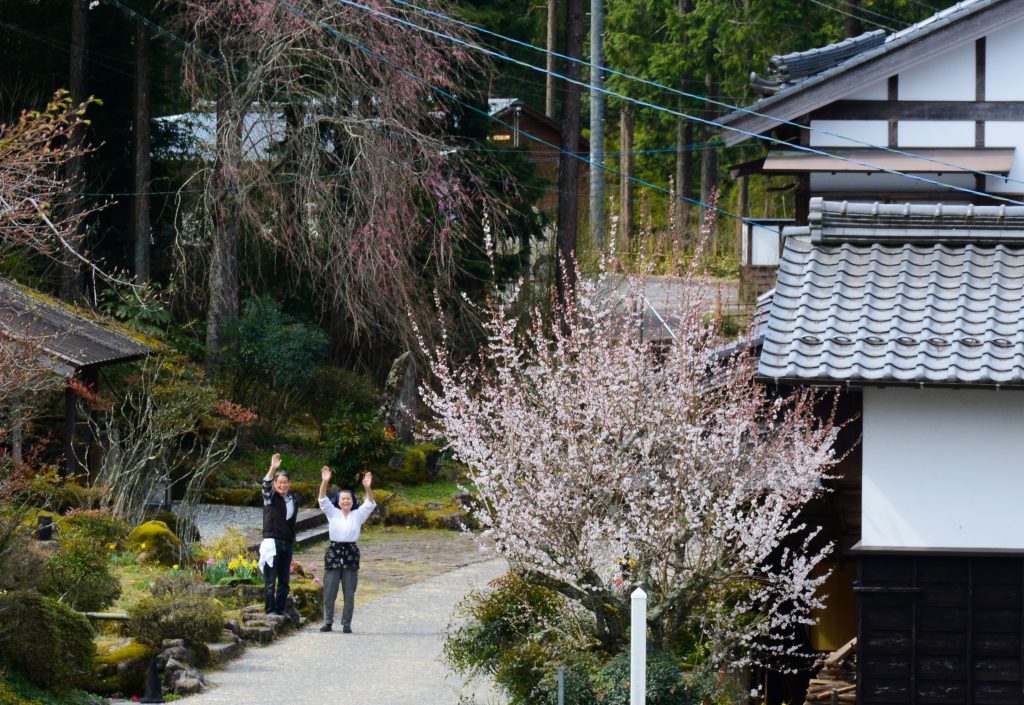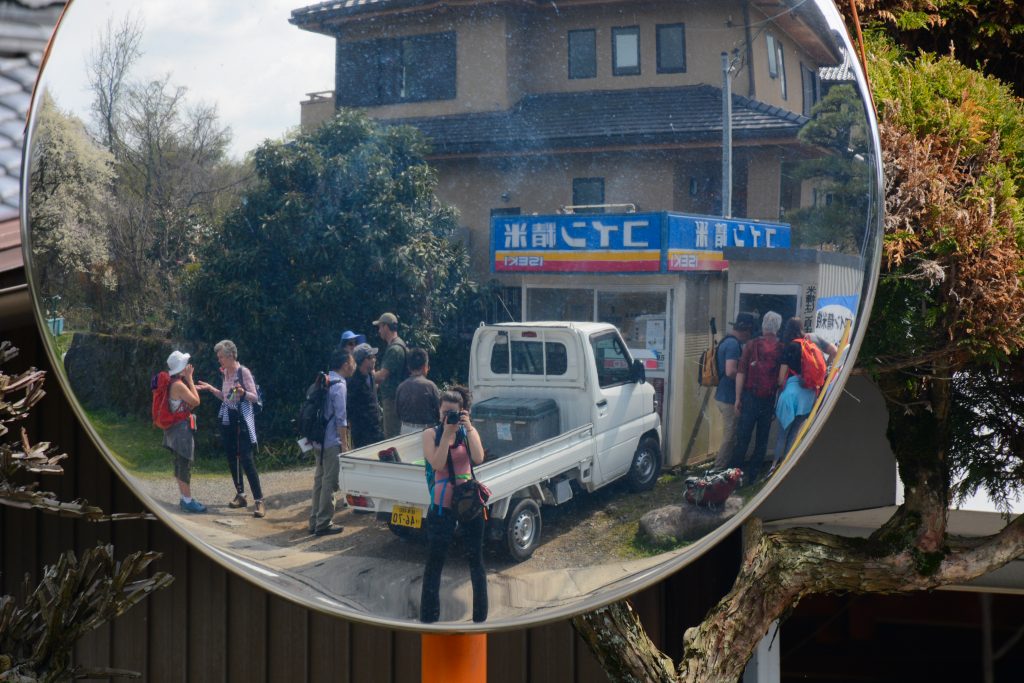On my first morning in a traditional Japanese ryokan on the Nakasendo, I awoke gently. Soft yellow light waltzed through the paper walls, warming my futon. Stretching from within my cozy cocoon, I listened to the shuffle of slippers and clinking of dishes from the hallway, just beyond the sliding doors. Our innkeeper was preparing tea.
This peaceful moment was only the prelude to my day on the Nakasendo Way. Soon, I would sit down for breakfast—freshly cooked rice and miso soup—strap on my backpack, and set off for another day of walking toward Tokyo.
From Kyoto to Tokyo on Foot

“I’m taking the bullet train from Tokyo to Kyoto and then walking back.” It wasn’t until I announced my travel plans for the first time that I realized how ridiculous it sounded. Even by bullet train, which in Japan travels at top speeds over 200 miles per hour, the trip between the cities takes more than two hours. But I was determined: I was going to walk back on the Nakasendo Way, one of Japan’s oldest highways.
During the Edo period (1603-1868), a time when Japan was peacefully governed by the shogun, highway systems like the Nakasendo Way were used by feudal lords, samurai, and even princesses to travel the country. The old trail of the Nakasando passes through mountains and valleys, carving a path through the Japanese Alps. The full journey took weeks, so to accommodate travelers, small towns—known as post towns—were established along the way. Each post town had inns offering travelers hot tea, fresh food, and soft futons. For 10 days I followed this course of history, sleeping in the same inns that once served the old travelers. While the samurai rode on horseback and princesses were carried by their subjects, however, I walked.
But I didn’t have to walk alone. I had signed on for a 10-day tour with Walk Japan, one of the only tour companies in Japan that specializes in guided walking tours of the Nakasendo. My guides booked the inns, made all the arrangements, and knew the road well. All I had to do was walk it.
Hiking for People Who Hate Camping

If you’re looking for bragging rights, the Nakasendo isn’t for you. The trail is mostly flat with ryokans and vending machines readily available. Along the road, you’ll never have to sleep outside or go more than a few hours without bottled water or a chilled can of coffee. Some days you’ll emerge from the forest to find yourself in a small town alongside locals strolling with their grandchildren and tending their backyard gardens. Other days you’ll climb through mossy forests high in the mountains and realize you’re in a part of Japan few foreigners have ever seen.
Every day on the trail was simultaneously new and familiar. I went in April—prime time for cherry blossoms. I strolled beneath wild plumes of pink, feeling a little less surprised every time I saw the burst of cherry blossoms, but still letting my gaze linger a little before moving on. Even without the fleeting cherry trees, the trail is embellished with historical gems. Tracing our path on the centuries-old ishidatami, the original stones that paved the Nakasendo, we passed through the ruins of tea houses, walked through fields where samurai tribes once battled, and nodded at the statues of Jizo, the Buddhist protector of travelers. Small, bald, and smiling, Jizos decorated with traditional red bibs line the Nakasendo all the way from Kyoto. At the feet of each were stacks of coins—the universal offering—and our guides encouraged us to leave our own tokens and say a small prayer for safe passage on our journey.
The Good Guides

On the trail there was never anything more to worry about than the storm clouds looming on our phones’ weather apps. Our guides had everything covered.
Yohei, our soft-spoken lead guide, had walked the trail with groups many times before. While we struggled on the occasional steep pass, he strolled with his backpack hanging off just one shoulder. Never far behind was our guide-in-training, Mamoru. When Yohei explained the history of a shrine or translated a haiku inscribed on one of the mossy stone markers, Mamoru was always a few steps away taking notes in his journal, learning the stories so he, too, could pass them on.
Because the Nakasendo is not a well-known trail, we saw few other people along the way. Most of those we did meet were on self-guided tours. I noticed a difference between our group and the independent hikers of the trail—while we spent our time taking in the scenery, confident in our guides, those who walked alone seemed less sure of themselves and less able to relax into their surroundings. The trail is well marked, but most signs are in Japanese only.
Off the trail it was just as useful to be with Yohei and Mamoru, as they communicated with the innkeepers (who rarely spoke English). Traveling with guides—who not only knew the language but also were deeply familiar with the cultural and historical significance behind everything we saw on the trail—kept everyone invaluably Zen.
Hiking the Nakasendo

Hiking the Nakasendo is an exercise in repetition. Each day we’d wake up on our ryokan futons, walk through quiet forests, sit down for a delicious meal, and fall asleep at a new inn, having made it just a little bit farther down the road. The days blurred together not because they were unmemorable, but because they were tranquil, like an impressionist painting. I relished the ryokans, knowing I would end each day with a hot cup of tea at a welcoming inn. I found connection and companionship among my fellow walkers—people who, like me, had found this obscure trail in an old travel book or by word of mouth. Though we met as strangers in the lobby of our modern Kyoto hotel, we ventured forward on our journey through old Japan together, and arrived in Tokyo as friends, brought together by a newfound appreciation for vending machines and the road less traveled.
More from SmarterTravel:
- Kyoto: Where ‘Old Japan’ is Alive and Well
- 11 Things Locals Want You to Know About Tokyo
- Walking the Great Wall of China: A Bucket-List Trip You Can Actually Afford
Jamie Ditaranto traveled to Japan and experienced the Nakasendo Way tour as a guest of Walk Japan. Follow her on Twitter @jamieditaranto and Instagram @jamieditaranto.
We hand-pick everything we recommend and select items through testing and reviews. Some products are sent to us free of charge with no incentive to offer a favorable review. We offer our unbiased opinions and do not accept compensation to review products. All items are in stock and prices are accurate at the time of publication. If you buy something through our links, we may earn a commission.
Related
Top Fares From
Today's Top Travel Deals
Brought to you by ShermansTravel
Greece: 9-Night Vacation, Incl. Meteora &...
Exoticca
 vacation
$2099+
vacation
$2099+
7- to 28-Night Mediterranean Cruises w/Onboard...
Holland America Line
 cruise
$1399+
cruise
$1399+
Ohio: Daily Car Rentals from Cincinnati
85OFF.com
 Car Rental
$19+
Car Rental
$19+




